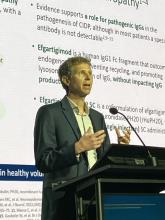DENVER — , according to the results of a phase 2 multinational trial, which were reported at the 2024 annual meeting of the American Academy of Neurology.
“Regardless of prior therapy for CIDP, efgartigimod PH20 was associated with a rapid clinical improvement, and clinical responses have been maintained out to 48 weeks,” said Jeffrey A. Allen, MD, an associate professor of neurology, University of Minnesota, Minneapolis.
Efgartigimod, which reduces circulating IgG immunoglobulin, has been available for the treatment of myasthenia gravis since 2021. In a new trial, called ADHERE, the combination of efgartigimod and rHuPH20 (E-PH20) was tested for CIDP, the most common of the chronic immune-mediated inflammatory polyneuropathies.
ADHERE Called Largest CIDP Trial to Date
In this study, which Dr. Allen called the largest randomized controlled trial ever performed with a CIDP treatment, a run-in stage was required for those candidates who were already on treatment. When these patients went off treatment during this 12-week run-in, clinical deterioration was required to advance to the first of two stages of the trial. Patients with symptomatic CIDP but off treatment at the time of enrollment did not participate in the run-in.
After the run-in, patients who advanced to stage A received 1000 mg of E-PH20 open label for 12 weeks. Of those on treatment prior to the run-in, about half were receiving intravenous immunoglobulins (IVIg). Almost all the remainder had been receiving corticosteroids. About 30% had been off treatment and entered stage A without participating in the run in.
The primary endpoint of stage A was the percentage of patients with evidence of clinical improvement (ECI). Patients who participated in the run-in were allowed to resume their prior treatment for stage A and the subsequent blinded stage B. Stage A was event driven so that it was closed once 88 events were reached,
The ECI endpoint was met by 66.5% of the patients, who thereby met eligibility for the randomized stage B. As the study design excluded those who achieved clinical improvement after the 88-event limit was reached, they were not included among responders. Had they been included, Dr. Allen said that the primary endpoint of stage A would have been reached by 70.4%.
The patterns of improvement in stage A were similar across type of prior CIDP treatment, including no treatment, according to Dr. Allen, who noted that 39.8% of those enrolled in stage A met the primary endpoint within 4 weeks.
There were 322 patients in stage A. Of these, 211 enrolled in stage B. They were randomized in a 1:1 ratio to 1000 mg of E-PH20 or placebo administered weekly by subcutaneous injection. Of those eligible for stage B, 40% had not participated in the run-in.
aINCAT Provided Primary Endpoint for CIDP Trial
For stage B, the primary endpoint was time from baseline to a clinically meaningful limitation of activity. This was evaluated with the adjusted inflammatory neuropathy cause and treatment (aINCAT) disability score.


